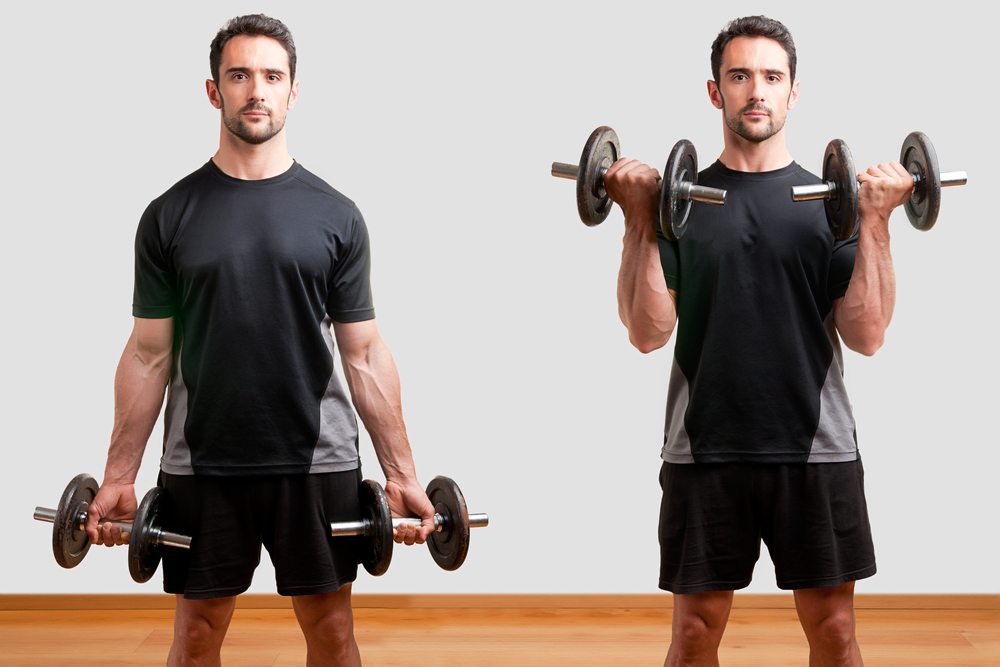There are two kinds of people in this world. People who want bigger biceps, and liars. Are you a liar, sonny? Probably not, if you’re reading this.
If you want big arms, you gotta curl. Which curl to choose? Let’s look at difficulty levels in curls today.
Are Barbell Curls Harder Than Dumbbell Curls?
The difficulty of the curl will depend mostly on the weight you use. For any given weight though, expect the barbell curl to be easier than the dumbbell curl.

Why Some People Find Barbell Curls Harder
The wrists gets beat up
Pain is usually the limiting factor in progressing the barbell curl. The number one culprit is the wrists.
For some people, barbell curls hurt their wrists.
The first thing to do here would be to check if it’s a load issue. If you’re going too heavy too soon, you can expect the wrists to ache.
If you’ve tried everything and the straight bar still kills you every time, there are alternatives.
Most commonly, swapping the straight bar for an EZ curl (also known as a triceps) bar can help massively.
You’ll likely have to reduce the load a little. EZ curl bars are HARD. They really lock you in and force strictness.
Usually, if you are experiencing wrist pain from a straight bar curl you’ll also have issues with chin-ups (palms facing towards you). That’s if you can access that range of motion in the first place.
If that’s you, you should go get that looked at by a trusted medical professional.
The lower back gets beat up
You can use a lot more weight curling a barbell. When you’re strong, you’ll easily be curling in excess of half your bodyweight for sets of 10+.
At the halfway point in this movement, the bar is far from the body. Here, the abs are doing a ton of work to keep the body upright.
There will be some swing and a little layback. This is unavoidable.
As fatigue sets in, there’s a risk of laying back too much. This bunches up the joints of the lower back.
Don’t be stubborn here.
Keep the weights reasonably strict, or use a wall to keep the movement honest. Barbell curls are an isolation movement.
Keep the focus on the biceps.
Why Some People Find Dumbbell Curls Harder
The dumbbell increments are too steep
When curling we’re not working with big weights in comparison to squats and deadlifts. Even with the bench press, the standard 2.5kg jump can be steep for smaller people starting out.
The margins for most people in the curl are even smaller. With the right set of fractional plates, you can tweak the load to be just right using a barbell.
With the dumbbells, you will usually have to work within jumps of 2-2.5kg per hand. This can make for slow and arduous progression.
I have tweaked my forearm so many times trying to go up in weight whilst maintaining the same number of reps. Listen to your body.
The weights are harder to stabilise
Assuming pain free, a barbell and plates will always be easier to lift than two dumbbells that add up to the same weight. It’s the same with pressing and other one arm movements too.
It’s just easier to stabilise a barbell with two arms than it is a pair of independently operating dumbbells.
The grip used makes a difference
Palms facing up, palms neutral (hammer curl), palms facing down, twisting… Every grip is a different exercise with its own difficulty curve.
If you’re going to quantify barbell vs dumbbell, I think you can only reasonably compare the palms facing up version to the barbell curl.
Even then, the size of the dumbbells will displace the weights away from the body, preventing you from fully resting at the bottom like you can with a barbell.

Are Reverse Barbell Curls Harder Than Dumbbell Curls?
Top secret: you can’t grow an injured arm! Reverse curls, when performed with either implement, are great for your elbows.
Think of reverse curls as rehabilitative and healthful. They’re in a separate class of exercises to other curls, with a different purpose. They are non-comparable.
I especially like a very slow negative, 5 seconds or more. Reverse curl the weight up, and slowwwwwly bring it back down.
I really like this movement for someone who gets elbow issues from lots of benching. You can’t use very much weight, but they are still a great movement to keep regularly in your training.
I’ve been in the fitness and strength training industry for nearly a decade. In that time, I’ve gained 30 pounds of muscle, written hundreds of articles, and reviewed dozens of fitness supplements. As for my educational background, I’m a currently studying for my Active IQ Level 3 Diploma in Personal Training.

